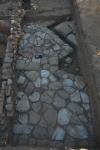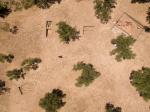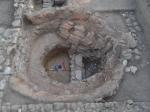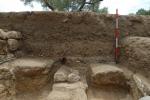Summary (English)
In 2017, the Austrian Archaeological Mission continued the exploration of the eastern quarter of the city in zone QE 3000. The main objective was to complete the excavation of the kiln FQE 3003, which began last year. Trenches to the south-east of this area were excavated in order to gain a preliminary idea of the chronological development of the large terrace in the south-eastern part of zone QE 3000. It was clear that the first traces of urban organisation in the south-eastern part, whose orientation was determined dalla direzione 7, were no earlier than the first half of the 3rd century B.C., therefore much later than the western part of the site (Vignale) where excavations in the 1980s brought to light 5th century B.C. pottery. In the second half of the 2nd or early 1st century B.C., the houses appeared to have been destroyed by landslides.
The development of the subsequent phase was documented in trenches 1/17 and 3/17, where a paving of large flysch stone slabs, covered by layers containing ash from the eruption of Vesuvius in 79 A.D. were identified. Similar situations had already been recorded in the western quarter on the road north of the House of the Frescoes, and also in the western part of the lower city.
In a later phase, probably in the 3rd century A.D., kiln FQE 3003 was built, of which only the part dug into the ground was preserved. The structure was oval in plan, on a north-south alignment, while the praefurnium, not excavated this year for reasons of time, is thought to be to the west, where two openings were found, one on top of the other. The double openings indicated two phases that will be clarified by further excavation. The combustion chamber presented a series of steps 0.50-0.60 m wide and 0.35 m high, surrounded by stone blocks and covered by brick and tile fragments.Typologically, kiln FQE 3003 finds a parallel in the kiln situated in the locality of Cellarullo, north-west of Benevento, dating to the early imperial period. In the southern part of the combustion chamber, and in the collapse in the northern part, there were several piles of under-fired quadrangular bricks. When the kiln went out of use, the entire structure was filled with stones and rubble. There were also large fragments of very coarse opus signinum. It was difficult to date the fill as most of the finds were residual, but a late antique date may be suggested.
Captions:
Fig. 1 Zona QE 3000 nel Quartiere Est – posizione dei saggi del 2017.
Fig. 2 Lastricato nel saggio 3/17.
Fig. 3 Saggio 1/17 SE – sezione con cenere dell’eruzione del Vesuvio.
Fig. 4 Fornace FQE 3003 da nord.
- Verena Gassner - Università di Vienna, Istituto di Archeologia Classica
Director
Team
- Andreas Hochstöger - Università di Vienna
- Angelo d’Angiolillo - Ascea
- Regina Klingraber - Università di Vienna
Research Body
- Università di Vienna - Istituto di Archeologia Classica
Funding Body
- Progetto del FWF (P 28 156-G025) “Urbanistic studies in the eastern quarter of Velia”






![Download [PDF]](/excavation/skins/fasti/images/results/download_sml.png)


